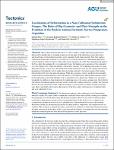Localization of Deformation in a Non‐Collisional Subduction Orogen: The Roles of Dip Geometry and Plate Strength on the Evolution of the Broken Andean Foreland, Sierras Pampeanas, Argentina
| dc.contributor.author | Pons, M | |
| dc.contributor.author | Rodriguez Piceda, C | |
| dc.contributor.author | Sobolev, SV | |
| dc.contributor.author | Scheck‐Wenderoth, M | |
| dc.contributor.author | Strecker, MR | |
| dc.date.accessioned | 2023-11-01T15:17:03Z | |
| dc.date.available | 2023-11-01T15:17:03Z | |
| dc.date.issued | 2023-08 | |
| dc.identifier.issn | 0278-7407 | |
| dc.identifier.issn | 1944-9194 | |
| dc.identifier.other | ARTN e2023TC007765 | |
| dc.identifier.uri | https://pearl.plymouth.ac.uk/handle/10026.1/21506 | |
| dc.description.abstract |
The southern Central Andes (SCA, 27°–40°S) exhibit a complex deformation pattern that is influenced by multiple factors, including the present‐day dip angle of the subducting oceanic Nazca plate and the influence of inherited heterogeneities in the continental South American plate. This study employs a data‐driven geodynamic workflow to assess the role of various forcing factors in determining upper‐plate strain localization, both above the flat slab and the steeper segment to the south. These include the dip angle of the Nazca plate, the mechanically weak sedimentary basins, the thickness and composition of the continental crust, the strength of the subduction interface, and the plate velocities. Our modeling results predict two main deformation modes: (a) pure‐shear shortening in the broken foreland above the flat‐slab segment and eastward propagation of deformation, and (b) simple‐shear shortening restricted to the eastern margin of the Andean fold‐and‐thrust belt above the steep‐slab segment. While the convergence velocity and the frictional strength of the subduction interface primarily control the intensity of the deformation, inherited heterogeneities tend to localize deformation, and weak sediments leads to intensified surface deformation. Thicker crust and surface topography also influences strain localization by transferring stress to the eastern orogenic front. Above the flat‐slab segment deformation migrates eastward, which is facilitated by enhanced interface coupling. The transition between the steep and sub‐horizontal subduction segments is characterized by a diffuse transpressional shear zone, likely controlled by the change in dip geometry of the Nazca plate, and the presence of inherited faults and weak sedimentary basins. | |
| dc.language | en | |
| dc.publisher | American Geophysical Union (AGU) | |
| dc.subject | subduction | |
| dc.subject | strain localization | |
| dc.subject | Sierras Pampeanas | |
| dc.subject | flat-slab | |
| dc.subject | Andes | |
| dc.subject | Nazca plate | |
| dc.title | Localization of Deformation in a Non‐Collisional Subduction Orogen: The Roles of Dip Geometry and Plate Strength on the Evolution of the Broken Andean Foreland, Sierras Pampeanas, Argentina | |
| dc.type | journal-article | |
| dc.type | Article | |
| plymouth.issue | 8 | |
| plymouth.volume | 42 | |
| plymouth.publisher-url | http://dx.doi.org/10.1029/2023tc007765 | |
| plymouth.publication-status | Published | |
| plymouth.journal | Tectonics | |
| dc.identifier.doi | 10.1029/2023tc007765 | |
| plymouth.organisational-group | |Plymouth | |
| plymouth.organisational-group | |Plymouth|Faculty of Science and Engineering | |
| plymouth.organisational-group | |Plymouth|Faculty of Science and Engineering|School of Geography, Earth and Environmental Sciences | |
| plymouth.organisational-group | |Plymouth|Users by role | |
| plymouth.organisational-group | |Plymouth|Users by role|Academics | |
| dcterms.dateAccepted | 2023-07-19 | |
| dc.date.updated | 2023-11-01T15:16:55Z | |
| dc.rights.embargodate | 2023-11-2 | |
| dc.identifier.eissn | 1944-9194 | |
| rioxxterms.versionofrecord | 10.1029/2023tc007765 |


